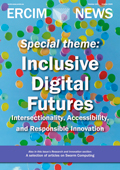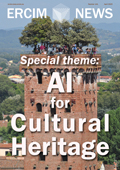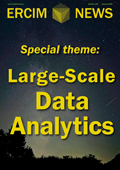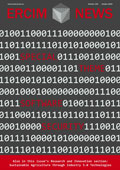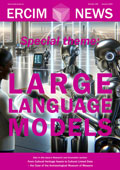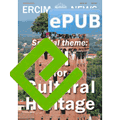by the guest editors George Pavlidis (Athena RC) and Laura Hollink (CWI)
Artificial Intelligence (AI) has become an integral part of the cultural heritage sector. Libraries, archives, and museums are increasingly employing AI to preserve, interpret, and engage with artifacts of historical and cultural significance. As such, the adoption of AI represents a significant leap forward for the sector. However, this progress brings ethical and practical challenges. Cultural heritage artifacts often reflect diverse and complex histories, and developing AI that can fully capture the breadth and nuance of these narratives is no trivial task. The societal role of cultural heritage institutions as trusted sources of information can sometimes conflict with AI systems that may produce biased results when trained on incomplete or skewed datasets. Moreover, many state-of-the-art AI systems operate as “black boxes,” which creates tension with the sector’s emphasis on data curation and provenance. As a result, there is a growing need for AI systems that are tailored to the specific values and requirements of the cultural heritage field.
This issue of ERCIM News explores “Cultural AI” — a domain that not only applies AI within the cultural heritage sector but also draws inspiration from cultural contexts to inform the design of more inclusive AI systems. The intersection of AI and Cultural Heritage offers a unique opportunity: the cultural heritage sector can help guide the development of AI toward more responsible directions. In doing so, it both benefits from technological innovation and contributes meaningfully to shaping the future of ethical AI.
The articles featured in this issue highlight the wide spectrum of applications in the cultural heritage field that benefit from AI, as well as the diverse forms of AI being employed across the sector. Examples range from the use of deep learning for monitoring the structural health of medieval monuments to LLM-driven dialogues in immersive user interfaces. These contributions, reflecting both the technological breadth and the enormous potential of AI in cultural contexts, can be divided into four connected themes.
AI for Preservation and Monitoring of Cultural Heritage
AI is playing an increasingly central role in the preservation and monitoring of cultural heritage, helping to safeguard historical sites and artifacts from both natural and human-induced threats. Patias et al. introduce the Unique Authenticity Identifier (UAI), a non-destructive AI-based tool for provenance research, designed to track unregistered cultural objects by comparing them to known items and enhancing traceability, particularly in the context of illegal trafficking. Georgiadis et al. present the ENIGMA project, which integrates AI and machine learning to combat illicit trafficking of cultural goods by providing tools for the identification, provenance research, and traceability of cultural artifacts. Their work emphasizes the importance of data integration and decision-support systems for heritage protection. Girardi et al. focus on the application of deep learning algorithms for monitoring the structural integrity of heritage buildings. Their approach uses AI to predict potential damage, improving early detection and proactive conservation strategies. Finally, Dagnaw et al. discuss the integration of Federated Digital Twins (FDT), an AI-powered technology that enables decentralised, multi-institutional collaboration for real-time monitoring and predictive analytics of cultural heritage sites. This innovative approach ensures that data privacy is maintained while fostering collaborative preservation efforts across institutions.
AI for Enhancing Museum and Visitor Experience
AI is also enhancing how visitors engage with cultural heritage, creating more personalised, immersive, and interactive experiences. Martusciello et al. present MuNDAR, a gamified augmented reality (AR) framework that combines AI and AR to enhance visitor engagement in museums and historical sites. By integrating generative AI, MuNDAR provides personalised narratives, challenges, and educational mini-games that adapt to individual visitor profiles. Toumpouri et al. explore the use of AI-driven Extended Reality (XR) to create intelligent virtual guides for heritage sites, offering personalised, real-time learning experiences. The Intelligent XR Assistant can adapt content based on visitors' interests and provide them with dynamic, context-aware information. Koukopoulos et al. describe CulturAI, a Mixed Reality (MR) application that integrates AI-driven conversational assistants to offer personalised tours of virtual art exhibitions. Visitors can interact with AI guides to learn about artworks, artists, and historical contexts, thus enhancing their engagement with digital art. Kosmopoulos et al. focus on the SignGuide project, which utilises AI to make museums more accessible to Deaf and Hard-of-Hearing (DHH) visitors. The system provides AI-powered sign language guidance, allowing DHH visitors to explore museum exhibits interactively and independently, thus bridging the accessibility gap in cultural heritage settings.
AI for Data Extraction and Cultural Heritage Management
AI is revolutionising the management and analysis of cultural heritage data, enabling institutions to process vast amounts of information more efficiently. Mountantonakis et al. describe TCRMQ, an AI tool that uses Large Language Models (LLMs) to generate CIDOC-CRM SPARQL queries from natural language text, allowing for easier querying of cultural heritage data in semantic web formats. Orero et al. introduce an AI-based multilingual search platform for audiovisual media archives, which enhances access to European cultural heritage by overcoming language barriers and improving search capabilities across diverse datasets. Ponsard et al. discuss the dual role of AI in computer museums, where it is both a curatorial tool for enhancing museum operations and an artifact in itself, reflecting on the history of technology. Puccetti et al. describe their work on the automatic extraction of medieval Latin regesta, enabling AI-driven summarisation of historical texts. Their method provides valuable insights for scholars by automating the extraction of concise summaries from lengthy Latin documents. Kontonasios et al. present the AI-driven extraction of structured data from historical newspaper archives, using AI tools to digitise and organize historical records, making them more accessible for academic research. Finally, Puccetti et al. return with a focus on the REVERINO dataset, which enables AI-driven summarisation of Latin historical texts, demonstrating the potential of AI to support digital humanities research through automated text processing.
Ethical, Philosophical, and Sustainability Considerations of AI
As AI becomes more integrated into cultural heritage practices, it raises important ethical, philosophical, and sustainability concerns. Fleischhacker et al. explore the philosophical implications of AI, questioning whether advancements in AI could lead to a “metaphysical humiliation” of humanity, challenging traditional notions of consciousness and free will. Barbierato et al. address the environmental impact of AI, proposing Green AI strategies to reduce the carbon footprint of AI technologies in cultural heritage applications. They advocate for energy-efficient AI practices, such as transfer learning, to mitigate the environmental cost of large-scale AI models. Daniil and Hollink highlight the challenges that public media, in particular libraries, face, when implementing a personalised recommender system. They show how popularity bias — a form of bias that is well known to exist in several recommender algorithms — leads to social bias. Taourarti et al. examine the cultural biases inherent in AI systems, specifically in the context of autonomous vehicles. They highlight how AI systems trained in one cultural context may perform poorly when deployed in regions with different driving behaviours and infrastructure, stressing the importance of culturally adaptive AI models. Ceolin et al. present a framework for analysing toxic memes, exploring how AI can help detect and classify harmful content in digital media. Their work highlights the importance of developing AI systems that can detect hate speech and other toxic content in online platforms, addressing the ethical challenges posed by AI's influence on social media.
Closing Thoughts
AI offers transformative opportunities for the cultural heritage sector, enhancing the preservation, interpretation, and accessibility of cultural assets. However, as these technologies continue to evolve, it is essential to address the ethical, philosophical, and environmental challenges they present. The contributions in this issue demonstrate the immense potential of AI to revolutionise cultural heritage practices, while also underscoring the need for responsible development and deployment of these technologies. By balancing innovation with ethical considerations, the cultural heritage sector can harness the power of AI to safeguard and enrich our shared history for future generations.
Please contact:
Laura Hollink, CWI, The Netherlands
George Pavlidis, ATHENA RC, Greece

